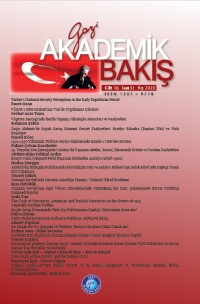Bir Kuşak Bir Yol Girişimi ve Türkiye: Türkiye Girişime Dâhil Olmalı mı?
One Belt One Road Initiative and Turkey: Should Turkey Be Involved in the Initiative?
Author(s): Erdem ATEŞ, Dilek SEYMENSubject(s): Politics / Political Sciences, History, Economy, Supranational / Global Economy, Economic history, Recent History (1900 till today), International relations/trade, Socio-Economic Research
Published by: Gazi Akademik Bakış
Keywords: One belt one road initiative; OBOR; gravity model; PPML; china; PCSEs; BRI;
Summary/Abstract: The People's Republic of China stands out with its high economic performance, especially in the last 20 years. The 2008 global crisis had a negative impact on China like the rest of the world. Thereupon, China went to search for new export markets and in 2013, the "One Belt, One Road (OBOR)" initiative was launched by Chinese President Xi Jinping. Later, the official name of the initiative was changed to Belt and Road Initiative (BRI). Initiative's sea route was called “21. Century Maritime Silk Road”, and the land route was called “Silk Road Economic Belt”. Within the scope of BRI, cooperation documents were signed with 140 countries and 30 international organizations as of September 2022. The aim of the initiative; It can be summarized as increasing the trade volume by making infrastructure and superstructure investments that reduce trade costs between the Asian, European and African continents. In addition, the initiative is thought to have many political, social and cultural goals.BRI's China-Central Asia-West Asia Economic Corridor (Central Corridor) is planned to pass through Turkey. It is thought that with this project, Turkey can gain profits by both acting as a bridge and by getting the chance to open up to new markets. The aim of the study; The aim is to analyze the relationship between exports and imports between the countries in the BRI and Turkey, and the transportation infrastructure. For this purpose, the 2007-2019 transportation infrastructure and foreign trade data of 118 countries and Turkey included in the initiative were analyzed by panel data method using gravity model. In order to include the transportation infrastructures of the countries in the model, some sub-items of the Logistics Performance Index (LPI) prepared by the World Bank were used. Two separate models were established for export and import, and Prais-Winsten (PCSEs) and Poisson Pseudo-Maximum Likelihood (PPML) estimators were used in the models. According to the results of the implementation, considering that BRI aims to develop transportation infrastructure opportunities, it is thought that Turkey's being a part of this initiative will have an increasing effect on foreign trade volume.
Journal: Gazi Akademik Bakış
- Issue Year: 16/2022
- Issue No: 31
- Page Range: 279-301
- Page Count: 23
- Language: Turkish

